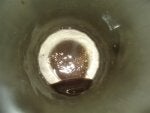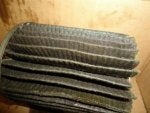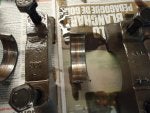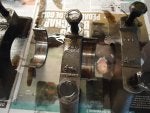Hey guys, I opened up my oil filter (using the special tool) and found copper flakes..What is a accepted amount?

Copper flakes in oil
Valve body
Discussion starter
275 posts
·
Joined 2009
- Add to quote Only show this user
Hey guys, I opened up my oil filter (using the special tool) and found copper flakes..What is a accepted amount?
Attachments
-
34.2 KB Views: 677
-
63.8 KB Views: 317
154 posts
·
Joined 2013
There is only a couple things that could cause it. If you are running a bronze gear there could cause some. But if not and it is from a bearing or rod bushing they are toast.
Valve body
Discussion starter
275 posts
·
Joined 2009
Nope no bronze gear...I guess the smart to do is to pull the engine (the trans is already out)..I guess some small sand sized particles are acceptable but flakes are a indicator of bearing failure. At least I caught it early by cutting up the filter and not creating more damage..
33,149 posts
·
Joined 2008
Play through the pleats in that filter with a clean magnet and see if it picks up any iron or steel. Put the oil from the filter in a plastic pan and run the magnet around under the bottom of the pan to see what reaction there is. If the oil follows the magnet or if the magnet affects the oil in any way it has microscopic particles of iron in it.
Valve body
Discussion starter
275 posts
·
Joined 2009
Thanks guys, I will use the magnet technique...I did got through the pleats and didn't see any iron or steel so hopefully it is just a bearing. When I get it on the engine stand, what caps should I remove to pinpoint the problem?
61,759 posts
·
Joined 2008
Check crank end play if it's the thrust bearing.
Posted via Mobile Device
Posted via Mobile Device
Valve body
Discussion starter
275 posts
·
Joined 2009
There does appear to be microscopic iron filings in it..I already have the trans out now so going to pull the engine. I just hope I caught it early enough to stop any major damage from happening..
Valve body
Discussion starter
275 posts
·
Joined 2009
Bad news guys, there was a thrust bearing failure. The endplay is like .027 lol...it looks like the crank journals are damaged as well..
If you go to 4:10 minute mark you can see the crank endplay..
I might get another short block, I figure it will need to align honed, crank at least cut/re-ground (but it is already cut) then perhaps re-balanced? and there could also be more damage than I think..I will have to evaluate the cost difference..the bearings look bad (I cannot post of pics here) the 2nd most rear actually looks like it spun a bit...
If you go to 4:10 minute mark you can see the crank endplay..
I might get another short block, I figure it will need to align honed, crank at least cut/re-ground (but it is already cut) then perhaps re-balanced? and there could also be more damage than I think..I will have to evaluate the cost difference..the bearings look bad (I cannot post of pics here) the 2nd most rear actually looks like it spun a bit...
Valve body
Discussion starter
275 posts
·
Joined 2009
Hopefully these pics works I am using my phone..
Attachments
-
70.1 KB Views: 424
-
77.6 KB Views: 290
-
64.8 KB Views: 275
-
72 KB Views: 273
1,864 posts
·
Joined 2008
Were the bearings too tight in the engine? I seem to remember you always having a problem cranking this engine over.
Valve body
Discussion starter
275 posts
·
Joined 2009
Yes, the question is why..I guess one scenario is a not doing a align hone to insure the caps were straight. Another scenario was the water mixing with the oil initially as I had a intake manifold leak this could have damaged the bearings. Although, I did cut open a filter after that and found no copper as compared to now (after some harder runs at track)..the bearing wear increase as you go back. The thrust bearing and #4 seem to have the most damage.
The clearances for the mains were #1-4 .0025 and #5 .003 but a too tight clearance could be a possibility. I had problems cranking it over when it was hot but I think that was a fuel issue. It seemed very sensitive to flooding when it was hot. To get it to start I had to open the throttle all the way and introduce a lot of air..
The clearances for the mains were #1-4 .0025 and #5 .003 but a too tight clearance could be a possibility. I had problems cranking it over when it was hot but I think that was a fuel issue. It seemed very sensitive to flooding when it was hot. To get it to start I had to open the throttle all the way and introduce a lot of air..
504 posts
·
Joined 2011
The copper was from the thrust bearing being worn down to the copper. That's normal for worn bearings. Maybe I'm wrong but I think you are over-reacting. Why not put bearings in at and run it?
Valve body
Discussion starter
275 posts
·
Joined 2009
The thing is the crankshaft journals (especially the thrust journal) might be damaged and a lot of the journals were rough. There was what appeared to be a groove on the thrust journal. The crankshaft would have to re-ground and might not even be usable..
I ended up dropping off the engine at a engine builders house and he will go through it and assess the damage,
I still don't know what caused it either so that would have to addressed so it won't repeat itself.
I ended up dropping off the engine at a engine builders house and he will go through it and assess the damage,
I still don't know what caused it either so that would have to addressed so it won't repeat itself.
3,575 posts
·
Joined 2015
Something has to be pushing on the crank to kill the thrust. Usually its related to some issue in the transmission. why did you take that out of the car? did you have the required clearance between the flex plate and the converter
2,061 posts
·
Joined 2008
And a performance oil pump, can't tell if it is HV or not, but a factory filter adaptor with the by pass not blocked. No No. The thing just sent the debris right back into the engine.
By pass needs to be plugged when the thing goes back together. That shit was made for stockers that people would never change their oil.
By pass needs to be plugged when the thing goes back together. That shit was made for stockers that people would never change their oil.
Valve body
Discussion starter
275 posts
·
Joined 2009
Hey guys, I removed the transmission to get the stall converter re-stalled. The flexplate to converter clearance was the 3/16 and the converter spun freely when installed. There was also no evidence that the converter was pushing on the pump such as flexplate to crankshaft bolts being scarred..
It is a high pressure pump, as far as I know the by pass isn't blocked
It is a high pressure pump, as far as I know the by pass isn't blocked
33,149 posts
·
Joined 2008
A damaged crank thrust can be the result of a restriction in the transmission cooler circuit caused by a kinked line or restricted fitting or ? High pressure in the converter pushes it forward on the stator support like a hydraulic jack.
7,264 posts
·
Joined 2008
I assume the engine builder knows how to 'set' the crank thrust by using a mallet to tap the crank forward and back BEFORE tightening the main the thrust is on?
I believe you know what to do:
As Yeti said, make sure the trans isn't an issue.
Since it's coming apart...
It's clear that the thrust was not the ONLY issue, as the rest of the bearings don't look good, either. The main bearings should clue you in to whether they are in alignment or not. If they were out of alignment, the wear will be inconsistent from bearing to bearing... and you should do a line hone to check/correct it. Were the rod bearings trashed as well? If so, it's likely a dirty assembly, or the issue with water in the oil.
Plug the bypass.
CLEAN, CLEAN, CLEAN everything during assembly!
Triple check all clearances.
Set the thrust.
Cross your fingers.
Good Luck!
I believe you know what to do:
As Yeti said, make sure the trans isn't an issue.
Since it's coming apart...
It's clear that the thrust was not the ONLY issue, as the rest of the bearings don't look good, either. The main bearings should clue you in to whether they are in alignment or not. If they were out of alignment, the wear will be inconsistent from bearing to bearing... and you should do a line hone to check/correct it. Were the rod bearings trashed as well? If so, it's likely a dirty assembly, or the issue with water in the oil.
Plug the bypass.
CLEAN, CLEAN, CLEAN everything during assembly!
Triple check all clearances.
Set the thrust.
Cross your fingers.
Good Luck!
Valve body
Discussion starter
275 posts
·
Joined 2009
Hey guys, I did some more searching for the potential cause of the thrust failure.The engine at the new persons shop I will look at potential trans causes while it is there.
I looked at the trans cooler lines and they are good. There was no kinks etc..I even ran some compressed air through them and there is fluid in them. So fluid is going through the lines.
I also looked at the rear seal of trans and noticed the seal was damaged a bit. I read on line that this could mean a driveshaft problem in which it pushes the trans internal components forward causing a thrust bearing failure? There was play in the u-joint area(side to side) but I figured it was normal.. here is a pic..
https://www.chevelles.com/forums/20-test-drive/1071072-test125890.html#post10910590
I don't have the converter or flexplate with me so I can't look for signs of enlarged flexplate/converter holes or other indicators the converter was pushing on the pump. I read sometimes the flexplate to crank bolts have a wear patter or the inner "button" on the exterior of the converter shows wear.
I didn't check the rod bearings, I just sent the the whole unit to the engine guy..I was frustrated and just sent the whole unit out..We should know in a few weeks when he takes it apart what happened to the rod bearings..
For the main bearing wear what I noticed was that the wear increased from rear to front. I also must remark that I didn't see the copper flakes until recently when the car was "pushed" at the 'strip. I shifted at 6500 rpm or so and until then it was mostly just backstreet test usage.and idling around town.
I looked at the trans cooler lines and they are good. There was no kinks etc..I even ran some compressed air through them and there is fluid in them. So fluid is going through the lines.
I also looked at the rear seal of trans and noticed the seal was damaged a bit. I read on line that this could mean a driveshaft problem in which it pushes the trans internal components forward causing a thrust bearing failure? There was play in the u-joint area(side to side) but I figured it was normal.. here is a pic..
https://www.chevelles.com/forums/20-test-drive/1071072-test125890.html#post10910590
I don't have the converter or flexplate with me so I can't look for signs of enlarged flexplate/converter holes or other indicators the converter was pushing on the pump. I read sometimes the flexplate to crank bolts have a wear patter or the inner "button" on the exterior of the converter shows wear.
I didn't check the rod bearings, I just sent the the whole unit to the engine guy..I was frustrated and just sent the whole unit out..We should know in a few weeks when he takes it apart what happened to the rod bearings..
For the main bearing wear what I noticed was that the wear increased from rear to front. I also must remark that I didn't see the copper flakes until recently when the car was "pushed" at the 'strip. I shifted at 6500 rpm or so and until then it was mostly just backstreet test usage.and idling around town.
Valve body
Discussion starter
275 posts
·
Joined 2009
Also, in a typical thrust bearing failure does only the thrust get affected or do the other bearings show damage? I am gonna say yes..
Valve body
Discussion starter
275 posts
·
Joined 2009
I also added some pics of the bearing failure with #'s that correspond.
https://www.chevelles.com/forums/20-test-drive/1071072-test125890.html#post10910590
https://www.chevelles.com/forums/20-test-drive/1071072-test125890.html#post10910590
-
?
-
?
-
?
-
?
-
?
-
?
-
?
-
?
-
?
-
?
-
?
-
?
-
?
-
?
-
?
-
?
-
?
-
?
-
?
-
?
- posts
- 24M
- members
- 152K
- Since
- 2005
A forum community dedicated to drag racing drivers and enthusiasts. Come join the discussion about racing, builds, pro mods, hot rods, events, turbos, nitrous, superchargers, and more!
Top Contributors this Month
View All
70FG
1.2K Replies
VinnyVette9340
1.2K Replies
Steve.k
1K Replies









